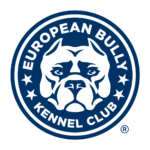A breed standard serves as the guideline defining the ideal characteristics, temperament, and appearance of a breed, including its correct color, ensuring it is fit for its function. Absolute soundness is essential. Breeders and judges should carefully avoid any exaggerated traits or obvious conditions that could negatively impact the health, welfare, or soundness of the breed. This is the original breed standard, crafted by the founding members of both the EBKC and ABKC, to establish a unified standard for the breed.
General Impression
The American Bully should convey strength relative to its size, with a compact, medium-to-large build, muscular body, and blocky head. It should appear heavily boned with a robust, bulky physique.
Characteristics
As a companion breed, the American Bully exudes confidence and a zest for life, with an enthusiastic desire to please and bond with its family, making it an exceptional family pet. Despite its powerful appearance, the American Bully has a gentle demeanor, excellent with children, and is friendly with strangers, other dogs, and animals. Human or dog aggression, extreme shyness, or viciousness are uncharacteristic and highly undesirable.
Head
The American Bully’s large, broad head is a key breed characteristic. Medium in length and deep, with a broad skull, prominent cheek muscles, and a distinct stop.
- Ears: Set high, can be natural or cropped.
- Eyes: All colors are equally accepted except albinism (pinkish to red) which is a disqualification. Blue eyes, lack of pigment around the eyes are undesirable with the exception of the merle/blotched coat pattern
- Faults: Overly visible haw, mismatched eye colors, bulging eyes.
- Disqualification: Albinism eyes.
- Muzzle: Short to medium, broad and blocky. Length should be about one-third of the skull, without interfering with breathing.
- Faults: Excessive length, weak underjaw, nose turned up or back.
- Bite: Tight scissor bite.
- Serious Faults: Severely overshot or undershot (1/4 inch or more).
Neck
Heavy, muscular, slightly arched, tapering from shoulders to skull, with minimal loose skin.
- Faults: Thin, weak, too short, or too long.
Forequarters
Strong, muscular shoulders with wide, well-laid blades; straight, sturdy forelegs, with large, round bones.
- Faults: Upright shoulders, bowed legs, weak pasterns, splayed or flat feet.
Body
A muscular, compact build, with a barrel chest and wide-spaced forelegs to allow chest development.
- Chest: Broad, deep, and well-filled, without exaggeration to impede movement.
Back
Short to medium length, straight or slightly sloping with a gentle slope at the rump. Should appear square and balanced.
- Faults: Weak topline, roached back.
Hindquarters
Well-muscled with balanced angulation, turning neither in nor out, and parallel when viewed from the rear.
- Faults: Cow hocks, bowed legs, narrow hindquarters.
Tail
Medium length, low set, tapering to a fine point, extending approximately to the hock.
- Faults: Tail too long or short, curled (gay tail).
- Serious Faults: Kinked, knotted, or fused tail.
- Disqualification: Screwed, bobbed, or docked tail.
Feet
Rounded, moderate size, compact, well-arched, and tight.
- Faults: Splayed or flat feet, long toes.
Coat
Short, glossy, smooth to the touch, and no longer than ½ inch.
- Faults: Curly or wavy coat.
- Serious Fault: Long coat.
Color and Pattern
All colours and patterns are permissible.
Size
The American Bully should be proportionate and not obese, with height and weight balanced with body frame.
- Standard Height: Males 17–20 inches (43–51 cm); females 16–19 inches (40–48 cm).
Gait
The American Bully moves with confidence, alertness, and a proud, effortless stride. Movement should be unrestrained, free, and powerful.
- Faults: Rolling, pacing, hackney action, crossing legs in front or rear.
FAULTS
Faults to be penalized but not disqualifications for showing are:
• Both eyes not matched in color
• Overly visible haw
• Bulging or protruding eyes
• Muzzle too long or snipey
• Lack of pronounced/deep stop
• Weak underjaw
• Underjaw turning up
• Albinism nose (light pink)
• Nose turning up or pushed back
• Tail too long or too short (approx. 1 inch (2.5 cm) from point of hock)
• Curled tail (gay tail)
• Level or flush bite
• Overshot or Undershot bite
• Wry or cross bite
• Neck too thin or weak
• Neck too short or too long
• Upright shoulders; steep and forward scapula (shoulder blade)
• Upper arm too short
• Severe turned fronts (in or out)
• Bowed front legs
• Down at the pasterns (weak pasterns)
• Splayed or flat feet
• Long toes
• Hocks turning in or out; cow hocked
• Curly or wavy coat
• Movement: Rolling, pacing, sidewinding, hackney action, and paddling or pounding
• Not moving on the same plane – legs over reaching, crossing over in front or rear, or rear legs moving too close or touching
SERIOUS FAULTS
Faults to be heavily penalized but not disqualifications for showing are:
• Severely overshot or undershot (1/4 inch (0.6cm)or more)
• Kinked tail
• Twisted tail
• Knotted tail
• Fused tail
• Overly Short tail
• Long coat
DISQUALIFICATIONS
• Displaying or possessing aggressive behavior towards humans
• Pink or Albino eyes
• Unilateral or bilateral cryptorchidism (missing one or both testicles)
• Unilateral or bilateral deafness (deafness in one or both ears)
• Screwed tail
• Bobbed tail
• Docked tail
Official Breed Standard written by the EBKC
Amendements (Coat Colours): May 2025
Amendments (Size Varieties): January 2010
Published: January 2006
First recognized in Europe: January 2008
